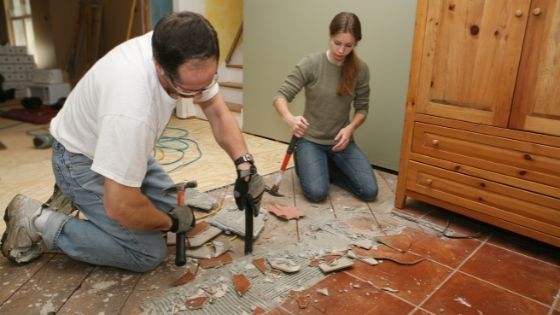You can’t start a new flooring project without removing old floor tiles. Finding the best way to remove floor tile depends on what kind of tile you have and how much of it you need to remove. If you’ve just moved into a house that’s been empty for a while, you might want to consider floor tile removal at Sunshine Coast before you start renovating. Renovating your home is a big project. It requires you to make some tough decisions and invest a lot of time and money into getting the job done. Whether you’re dealing with removing floor tiles or tile removal in general, there are certain things that you need to know about the process.
1. It can be inexpensive — and fast
Removing the tiles shouldn’t cost more than $50, says Laura Boggs, a project manager at Renovation Pros in St. Paul, Minnesota, who has removed tile floors in lots of homes over the years. At most big-box stores, like Home Depot or Lowes, it’s often just a couple of dollars per square foot of tile to remove.
2. Floor tiles don’t come off easily
If you haven’t done this before, you may be surprised by how difficult it can be to remove an existing floor tile. Some tile floors are glued down with a thin set mortar that hardens and adheres very well to the subfloor below. This makes it very difficult for you to remove without damaging the subflooring. If you find your tile is stuck fast, use a chisel or pry bar to carefully remove the grout around the tiles that you want to take out.
3. You might find hidden hazards
Make sure you check behind the walls and behind electrical outlets before starting your work. “Sometimes there’s cable or wires running through the floor,” Boggs says. “The last thing you want is to break something.”
4. The secret to success is preparation
If you have an electrician in your family, he or she can do some preliminary testing on the floor and make sure it’s safe before tearing up the old tiles. But if you’re doing it yourself, use caution: “You need to be extra careful because if it’s wet from rain or something else,
5. What’s underneath?
If your home is older, it’s likely that the floors are made of wood, vinyl or some combination of both. If so, it’s time to take a close look at what’s underneath. If there is anything that shouldn’t be ripped out — such as plumbing under the tile — these materials need to be removed first.
6. Location
Flooring may require special care depending on where it’s located. For example, carpet is popular in kitchens and bathrooms because it doesn’t stain easily or create a lot of static electricity; however, tile floors may be preferred in other areas of the home due to their durability and ease of cleaning.
7. Use protective gear
Removing floor tiles means working with broken pieces, dust and grout. Wear safety glasses and a face mask when removing the tiles to protect your eyes, nose and throat from dust particles.
8. Know your tile type
Ceramic and porcelain tiles are more brittle than stone tiles, so they’ll break into smaller pieces that are easier to clean up. Stone tiles like marble or granite will require more time and force to pry loose from the floor.
9. Choose your chisel wisely
Whether you’re using a hammer or power tool, choose a chisel that’s about 1/4-inch wider than the grout spacing between your tiles. This will make it easier for you to pry up the tile. If you’re using a hammer, choose one that has a high-quality head that won’t chip or crack under pressure.

















